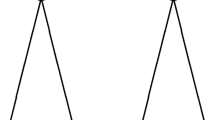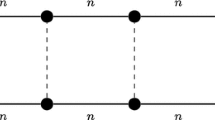Abstract
A chain probe graph is a graph that admits an independent set S of vertices and a set F of pairs of elements of S such that G+F is a chain graph (i.e., a 2K 2-free bipartite graph). We show that chain probe graphs are exactly the bipartite graphs that do not contain as an induced subgraph a member of a family of six forbidden subgraphs, and deduce an O(n 2) recognition algorithm.
Similar content being viewed by others
References
Berry, A., Golumbic, M. C., & Lipshteyn, M. (2004). Two tricks to triangulate chordal probe graphs in polynomial time. In Proc. SODA’04, 962–969.
Berry, A., Golumbic, M. C., & Lipshteyn, M. (2007). Cycle-bicolorable graphs and triangulating chordal probe graphs. SIAM Journal on Discrete Mathematics, 21, 573–591.
Brandstädt, A., Le, V., & Spinrad, J. P. (1999) Graph classes: A survey. SIAM Monographs on Discrete Mathematics and Applications, Philadelphia.
Chandler, D. D., Chang, M.-S., Kloks, T., Le, V. B., & Peng, S.-L. (2008). Probe Ptolemaic graphs. In Proc. COCOON 2008. Lecture notes in computer science (Vol. 5092, pp. 468–477).
Chang, M.-S., Kloks, T., Kratsch, D., Liu, J., & Peng, S.-L. (2005). On the recognition of probe graphs of some self-complementary classes of perfect graphs. In Proc. COCOON 2005. Lecture notes in computer science (Vol. 3595, pp. 808–817).
Chvátal, V., & Hammer, P. (1977). Aggregation of inequalities integer programming. Annals of Discrete Mathematics, 1, 145–162.
Golumbic, M. C. (2004). Algorithmic graph theory and perfect graphs (2nd edn.) Annals of discrete math., Vol. 57. Amsterdam: Elsevier.
Golumbic, M. C., & Lipshteyn, M. (2003). Chordal probe graphs (extended abstract). In Proceedings of WG’03. Lecture notes in computer science (Vol. 2880, pp. 249–260).
Golumbic, M. C., & Lipshteyn, M. (2004). Chordal probe graphs. Discrete Applied Mathematics, 143, 221–237.
Golumbic, M. C., & Trenk, A. N. (2004). Tolerance graphs. Cambridge: Cambridge University Press.
Golumbic, M. C., Kaplan, H., & Shamir, R. (1995). Graph sandwich problems. Journal of Algorithms, 19, 449–473.
Hammer, P. L., Peled, U. N., & Sun, X. (1990). Difference graphs. Discrete Applied Mathematics, 28, 35–44.
Johnson, J. L., & Spinrad, J. P. (2001). A polynomial time recognition algorithm for probe interval graphs. In Proc. 12th annual ACM-SIAM symp. on disc. algorithms (SODA) (pp. 477–486).
Le, V. B., & de Ridder, E. (2007a). Probe split graphs. Discrete Mathematics and Theoretical Computer Science, 9, 207–238.
Le, V. B., & de Ridder, E. (2007b). Characterisations and linear-time recognition of probe cographs. In Proc. WG 2007. Lecture notes in computer science (Vol. 4769, pp. 226–237).
Mahadev, N. V. R., & Peled, U. N. (1995). Threshold graphs and related topics. Annals of discrete mathematics (Vol. 56). Amsterdam: Elsevier.
McConnell, R. M., & Spinrad, J. P. (2002). Construction of probe interval models. In Proc. 13th annual ACM-SIAM Symp. on disc. algorithms (SODA) (pp. 866–875).
McMorris, F. R., Wang, C., & Zhang, P. (1998). On probe interval graphs. Discrete Applied Mathematics, 88, 315–324.
Przulj, N., & Corneil, D. G. (2005). 2-Tree probe interval graphs have a large obstruction set. Discrete Applied Mathematics, 150, 216–231.
Sheng, L. (1999). Cycle free probe interval graphs. Congressus Numerantium, 140, 33–42.
Yannakakis, M. (1981). Node-deletion problems on bipartite graphs. SIAM Journal on Computing, 10, 310–327.
Zhang, P. (1994). Probe interval graphs and their application to physical mapping of DNA. Manuscript.
Zhang, P., Schon, E. A., Fischer, S. G. Cayanis, E. Weiss, J. Kistler, S. & Bourne, P.E. (1999a). An algorithm based on graph theory for the assembly of contigs in physical mapping of DNA. CABIOS, 10, 309–317.
Zhang, P., Ye, X., Liao, L., Russo, J., & Fischer, S. G. (1999b). Integrated mapping package—a physical mapping software tool kit. Genomics, 55, 78–87.
Author information
Authors and Affiliations
Corresponding author
Additional information
This research was made possible by the joint French–Israeli project Recognition, Decomposition, and Optimization Problems in Graph Theory.
Rights and permissions
About this article
Cite this article
Golumbic, M.C., Maffray, F. & Morel, G. A characterization of chain probe graphs. Ann Oper Res 188, 175–183 (2011). https://doi.org/10.1007/s10479-009-0584-6
Published:
Issue Date:
DOI: https://doi.org/10.1007/s10479-009-0584-6




